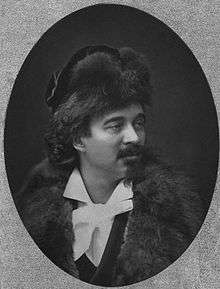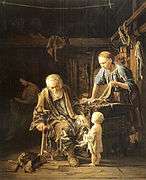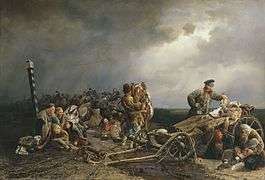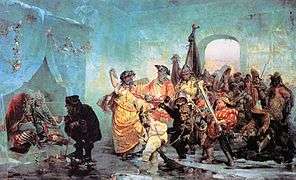Valery Jacobi
| Valery Jacobi | |
|---|---|
 | |
| Born |
Valery Ivanovich Jacobi 15 May [O.S. 3 May] 1834 Kazan Governorate |
| Died |
13 May 1902 (aged 67) Nice |
Valery Ivanovich Jacobi (Russian: Валерий Иванович Якоби or Якобий; 15 May [O.S. 3 May] 1834, Kudryakovo, Kazan Governorate, Russia - 13 May 1902, Nice, France) was a Russian painter[1] and an older brother of Pavel Jacobi (1842–1913), a notable revolutionary and ethnographer.[2][3]
Biography
Valery Jacobi was born to a family of an estate owner and started his education in the Kazan University, but broke off studying to enlist in the Russian Army[1] (Siberian Volunteer Corps[4]) during the Crimean War. In 1856 after retirement from the Army he decided to abandon his University studies and pursue an artistic career instead.[1]
In 1856-1861 he studied at the Imperial Academy of Arts, receiving a small gold medal for his painting "Serene Holiday of a Beggar" (1860). In 1861 he painted what may be his most notable painting "The Prisoner's Rest". In 1861-1869 Jacobi traveled to Europe with an Academy grant, visiting Germany, Switzerland, France and Italy.[1]
In 1870 Jacobi became one of the founding members of the Peredvizhniki art society. But in 1872 he was excluded for his failure to participate in a society exhibition[1] and his general disagreement with the ideals of the society.[4] Later he was considered a conservative, sceptical to the Peredvizhniki's ideas.
Jacobi was a member of the Imperial Academy of Arts after 1868, became a professor in 1871 and taught at the Academy from 1878-1889.[2] He lived mostly in Saint Petersburg creating historical paintings like "Jesters at the Court of Anna Ioanovna" (1872), "Ice Palace" (1878), etc. His works were criticized as purely decorative and lacking in substance.[4]
After a major reorganization of the Academy in 1891, he was dismissed and began dividing his time between Saint Petersburg, Algeria and France. Jacobi died in Nice in 1902.
Works
 Serene Holiday of a Beggar, 1860
Serene Holiday of a Beggar, 1860 The Prisoner's Rest, 1861
The Prisoner's Rest, 1861.jpg) Jesters at the Court of Empress Anna, 1872
Jesters at the Court of Empress Anna, 1872 Ice palace of Empress Anna, 1878
Ice palace of Empress Anna, 1878 Ninth Thermidor, 1864
Ninth Thermidor, 1864 An Oriental Beauty, 1881
An Oriental Beauty, 1881 The Inauguration of the Academy of Arts, 1889
The Inauguration of the Academy of Arts, 1889
References
- 1 2 3 4 5 Valery Jacobi in Krugosvet Online Encyclopedia (Russian)
- 1 2 Valery Jacobi in Great Soviet Encyclopedia
- ↑ Pavel Jacobi in Great Soviet Encyclopedia
- 1 2 3 Valery Jacobi on Pointart library
External links
![]() Media related to Valery Jacobi at Wikimedia Commons
Media related to Valery Jacobi at Wikimedia Commons